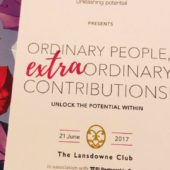 If you’re a CEO or a Managing Director of a team or a business, you will have noticed that things are changing. Fast. So fast that most of us are finding it hard to keep up. The amount of information being flung at us is nearly insurmountable. To such an extent that, in order for us to digest as much of it as possible, we dedicate an average of 3 seconds to any digital message (emails, tweets, blogs etc) before we decide whether it is going to capture our interest or end up in the ever-growing junk box.
If you’re a CEO or a Managing Director of a team or a business, you will have noticed that things are changing. Fast. So fast that most of us are finding it hard to keep up. The amount of information being flung at us is nearly insurmountable. To such an extent that, in order for us to digest as much of it as possible, we dedicate an average of 3 seconds to any digital message (emails, tweets, blogs etc) before we decide whether it is going to capture our interest or end up in the ever-growing junk box.
You will have noticed the louder voices of so-called minorities – women, Millennials, the politically-neglected – urging the incumbent regime and processes to change.
You will have noticed technological advances – from the speed with which information is spread to the integration of artificial intelligence with human endeavours – that affect our daily interactions.
The world is undoubtedly changing. Here are five concrete reasons to ask yourself whether you have the right people on your team to embrace those changes:
- Ever-growing complexity
The explosion of available knowledge and information nowadays makes it impossible for any one person – no matter how clever – to absorb it all. The sheer vastness of information and the advances that we have made in mathematics, science, genetics, medicine, etc. make any one person’s job to understand how that knowledge interacts in order to solve one problem far too complex for any one type of person. The need to solve complex problems infers a need for diversity. The only way that vast pools of knowledge in different disciplines can be leveraged to solve complex problems is by bringing together a group of individuals who hold vastly different types of information, experience and knowledge.
Consider this example: In 2006, Netflix CEO Reed Hastings asked the public to help Netflix predict viewer film ratings. Netflix announced an open competition, rewarding anyone who outperforms their own Cinematch consumer film rating algorithm by at least 10% with $1 million. Various groups went to task. Among them, teams of mathematical whizzes, computer programmers, psychologists, engineers and data scientists. Each team did all it could to improve the algorithm. A couple of the teams achieved remarkable success by improving Cinematch’s accuracy by over 8%. But not any one single team was able to get any closer to the requisite 10% in order to win the grand prize.
You can probably guess what happened next. The top-performing team realised that their knowledge alone was not going to be enough to crack this code and offered to collaborate with other teams that had vastly different experience and knowledge. The team of data scientists collaborated with a team of computer programmers and a team of psychologists. Each group, however intelligent, operated on a set of assumptions that defined its knowledge, blinded by a number of facts that were disguised by these assumptions. It is only when the teams came together and broadened their understanding of complex human behaviour that they were able to succeed.
 So, while, individually, each team had vast knowledge and understanding of their area of expertise, it was not until they combined the very different knowledge and experience that they were able to exceed the requisite 10% threshold.
So, while, individually, each team had vast knowledge and understanding of their area of expertise, it was not until they combined the very different knowledge and experience that they were able to exceed the requisite 10% threshold.
In today’s world, most business problems are complex. They are complicated by the fact that systems are at once different (depending on where in the world they might be located) and yet are connected through the power of technology. They are complicated by the sheer layers of possible outcomes. They are complicated by different tax structures, legal instruments and cultural behaviours in different jurisdictions. Even a business that works solely in one country will not be able to escape the every-growing complexity of our world because – no matter where we operate – we are digitally connected to each other and, as a result, influenced by everything that’s happening around us, be it in our community or on the other side of the world. While IQ is important, as the example demonstrates, IQ itself is no longer sufficient to solve the problem – you need cognitive diversity, the different ways in which we interpret situations and solve problems. Chances are, if you’re recruiting the most intelligent people out there, you’re recruiting a very similar type of thinker. In order to grow the diversity pool in your business, stop paying attention to old recruitment habits (including the level of someone’s intellect) and start thinking about how to get as diverse a pool of candidates as you can muster.
- Rising global middle class
The world’s middle-class population growth has shifted from established market jurisdictions to those we consider as ‘emerging’. Our global middle-class population is estimated to grow from approximately 3 billion in 2015 to over 5 billion by 2030. Half of this growth is occurring in Asia (China and India) as well as other emerging markets, including Sub-Saharan Africa and Latin America.
 The explosion of the middle-class population presents the single biggest opportunity for most businesses. Yet to take advantage of those opportunities, a business must be finely calibrated to understand the complexities of those diverse emerging markets where the opportunities arise. Countries like China, Vietnam, India, South Africa and Nigeria (to name a few) are all culturally diverse, economically volatile and politically charged. To successfully navigate markets in those countries and to take advantage of opportunities in those markets, business must understand and be fluent in the cultural intricacies of those jurisdictions. Competition from local businesses is vast and local talent is scarce. So in order for any company to successfully engage in the market where opportunities arise, it will need to make space for a diverse employee base and build an environment which doesn’t just attract people from different backgrounds and experiences but is also able to retain them and, most importantly, allow them to contribute with those valuable differences that they bring to the table.
The explosion of the middle-class population presents the single biggest opportunity for most businesses. Yet to take advantage of those opportunities, a business must be finely calibrated to understand the complexities of those diverse emerging markets where the opportunities arise. Countries like China, Vietnam, India, South Africa and Nigeria (to name a few) are all culturally diverse, economically volatile and politically charged. To successfully navigate markets in those countries and to take advantage of opportunities in those markets, business must understand and be fluent in the cultural intricacies of those jurisdictions. Competition from local businesses is vast and local talent is scarce. So in order for any company to successfully engage in the market where opportunities arise, it will need to make space for a diverse employee base and build an environment which doesn’t just attract people from different backgrounds and experiences but is also able to retain them and, most importantly, allow them to contribute with those valuable differences that they bring to the table.
- Increased customer sophistication
In this world that we now live in, where information about any given product or service is readily available, anyone who is looking for something specific, original or unique will be able to find it.
This in turn makes it difficult for companies. Not only do businesses have to closely and fully understand their customers, they also need to be able to differentiate themselves from any other company that is providing a similar service or product. As competition increases, companies cannot afford not to fully empathise and connect with their customers. Brand loyalty is a thing of the past and may not even exist in the new emerging middle classes. To satisfy a fickle client-base, teams and leader must work harder, first to attract an employee base that reflects this nuanced and diverse demand and then to retain and harness its value.
 In order to do that, companies will require teams of people who reflect the diversity of their customer base. They will need to be closely connected to the customer and understand the nuances of individualised demands of millions of customers in order to deliver the requisite customer experience.
In order to do that, companies will require teams of people who reflect the diversity of their customer base. They will need to be closely connected to the customer and understand the nuances of individualised demands of millions of customers in order to deliver the requisite customer experience.
In addition, these teams will need to improve their empathy skills in order to better understand what customers want and how they want to be treated. As empathy is the main component of an inclusive environment, and inclusive team and leader will be better placed to take advantage of the diversity existing in that team and of those demanding sophisticated customers with highly individualised requirements.
- Innovation and Creativity
Innovation is the name of the game for any company. In fact, of 1500 CEOs surveyed in recent years, 75% put innovation as a top 3 priority for their business. Irrespective of the nature of your business, keeping up and staying ahead might be the difference between a company that survives and a company that doesn’t.
 It will come as no surprise that the best way to innovate and create is to draw from a very diverse base. The wider you cast your net for new ideas, the better your chances for breakthrough innovation. Inviting and encouraging diverse thinking in your team is fundamental to any organisation that aims to garner new ideas. Leaders will need to become more self-aware in order to guard against groupthink in their midst and to ensure they aren’t blindsided by something that a more diverse environment would have identified as a risk or an opportunity. Those who understand the greater benefits of being supported by a diverse range of thinkers (and the sacrifices that one’s ego must make in order to tolerate and, in fact, welcome dissent) stand to gain the most. A team that is diverse and is routinely freely speaking its mind will be better placed to spot those rare opportunities, develop new ideas and prevent poorly thought-through decisions.
It will come as no surprise that the best way to innovate and create is to draw from a very diverse base. The wider you cast your net for new ideas, the better your chances for breakthrough innovation. Inviting and encouraging diverse thinking in your team is fundamental to any organisation that aims to garner new ideas. Leaders will need to become more self-aware in order to guard against groupthink in their midst and to ensure they aren’t blindsided by something that a more diverse environment would have identified as a risk or an opportunity. Those who understand the greater benefits of being supported by a diverse range of thinkers (and the sacrifices that one’s ego must make in order to tolerate and, in fact, welcome dissent) stand to gain the most. A team that is diverse and is routinely freely speaking its mind will be better placed to spot those rare opportunities, develop new ideas and prevent poorly thought-through decisions.
- Change in Demographics and Talent
The world is becoming older, better educated and easier to transverse. In addition, the way people work and what they expect in return in terms of future opportunities, respect for life outside work and where and when they work has been undergoing a seismic shift.
The world’s change in demographic is unprecedent and is on our doorstep. According to a number of sources that monitor and routinely predict demographics, by 2020 (at the latest), those older than 65 will outnumber those under the age of 5. In fact, it is predicted that, by 2050, the world’s population of those over 65 will represent 15.6% of the global population (up from 10% today) and those under the age of 5 only 7.2%. This will impact our workforce.
In addition, higher education in developing countries is becoming more accessible, generating a highly-educated, highly mobile educated workers, looking for opportunities elsewhere.
By way of example, it is estimated that, by 2030, China will generate more university graduates that the entire US workforce. By 2020, India is predicted to produce four times as many graduates as the United States. Given where the educated workforce will be coming from, companies will need to be able to attract a vastly different person – from every perspective – and demonstrate and ability to retain them.
And when it comes to workplace expectations, the so-called Millennials (those born between 1980 and 1996) have a thing or two to say about this. Expected to represent 50% of the workforce in the UK (and 35% of the global workforce) by 2020, any business that chooses to ignore the demands of this generation does so at its perils.

SONY DSC
What are those demands, you ask? Generally speaking, Millennials have been seen to be the one generation that isn’t afraid to vote with their feet. An average stay for a Millennial at any given job is 18 months. Why do they leave? For better opportunities. Millennials, more so than other generations represented in the workforce find it ‘extremely important’ to have opportunities to learn and grow, to have good leaders and managers (defined by their own criteria including transparency, coaching, motivation and purpose), having an interest in the role and the type of work. They are not, necessarily, motivated by money alone.
These massive shifts in demographics and attitude require a very different approach to harnessing talent. Being mindful of diversity and how to attract and retain it plays a major role in a company’s ability to win or lose the ‘war on talent’.
The question for you is, do you have the right team to tackle these changes and succeed as a business? Do you have the diversity that you need to embrace the changes and opportunities or does your team look predominantly like you and is therefore at risk of being blindsided? If you don’t have the requisite diversity on your team, ask yourself what’s missing and how you can attract and retain it. If you’re willing and able to make a change to prepare your team and company, the time to act is now!



 At Voice At The Table, we’ve been working on developing inclusive cultures for some time now: identifying the starting point, describing the look and feel of an inclusive workplace, and supporting our clients in designing and developing their own inclusive and diverse teams.
At Voice At The Table, we’ve been working on developing inclusive cultures for some time now: identifying the starting point, describing the look and feel of an inclusive workplace, and supporting our clients in designing and developing their own inclusive and diverse teams.

 We invited delegates representing a myriad of industries (including law, banking, insurance, the armed forces, consulting, engineering, and tech) to explore how, as individual contributors, they can bring their whole selves to work.
We invited delegates representing a myriad of industries (including law, banking, insurance, the armed forces, consulting, engineering, and tech) to explore how, as individual contributors, they can bring their whole selves to work. ote speaker, Miriam Gonzaléz Durantéz talked of the importance of respecting one another, both at work and at home. Respect evidences itself not just by being polite and kind but by allowing the other person the same liberties and entitlements as one allows himself or himself.
ote speaker, Miriam Gonzaléz Durantéz talked of the importance of respecting one another, both at work and at home. Respect evidences itself not just by being polite and kind but by allowing the other person the same liberties and entitlements as one allows himself or himself. We then heard from a panel of speakers, including Claire Bennett, a former professional fencing athlete, about integrating skills they developed in personal passions into their daily work routines. Claire, who now helps former professional athletes to transition into other professions, frequently falls back on the skills she developed as an elite athlete. Skills like resilience, motivation, endurance, commitment, drive and initiative are the foundation of every elite athlete which will serve any of us working for a successful business.
We then heard from a panel of speakers, including Claire Bennett, a former professional fencing athlete, about integrating skills they developed in personal passions into their daily work routines. Claire, who now helps former professional athletes to transition into other professions, frequently falls back on the skills she developed as an elite athlete. Skills like resilience, motivation, endurance, commitment, drive and initiative are the foundation of every elite athlete which will serve any of us working for a successful business. Chuck Stephens of Google shared with us ways in which he inspires employees to bring their whole selves to work. Having observed that certain unwanted consequences disappear once they have been openly highlighted, Chuck and the company emphasise these ramifications, allowing employees to self-manage their own behaviours.
Chuck Stephens of Google shared with us ways in which he inspires employees to bring their whole selves to work. Having observed that certain unwanted consequences disappear once they have been openly highlighted, Chuck and the company emphasise these ramifications, allowing employees to self-manage their own behaviours.







